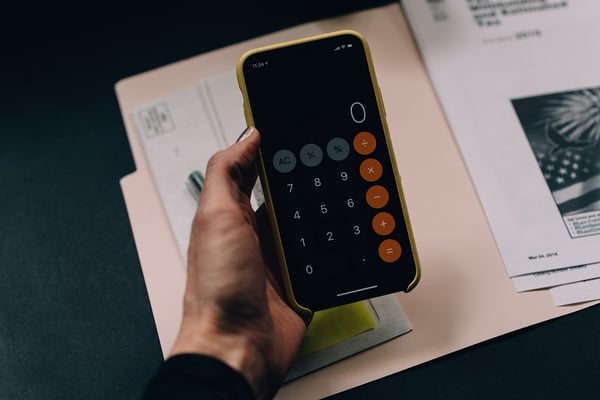It’s not uncommon for small businesses to face financial difficulty. However, when a business is struggling, it can be really difficult for sole traders as they are liable for the business debt - and if problems aren’t dealt with straight away, debt can continue to build up resulting in the risk of bankruptcy. In these situations, an Individual Voluntary Arrangement, or IVA, is a powerful solution.
An Individual Voluntary Arrangement is an insolvency tool that ringfences your creditors to relieve some of the financial pressure. So, read on if you are wondering 'can you be self-employed with an IVA' and find out how IVAs work, what the process involves, if you can be self-employed with an IVA, the advantages and disadvantages and more...
What is an IVA?
An IVA is a deal between an insolvent sole trader and its creditors. An IVA is a formal procedure that was originally established as an alternative to bankruptcy, and for an individual with assets it is often considered the most suitable option because it offers protection over those assets. It is a legally binding contract that allows you to repay some or all your debts from your future profits over a set period, usually between five and seven years. Debts that can be dealt with via and IVA include personal loans, credit card debts and other unsecured loans.
With an IVA, you only repay what you can afford and once the IVA period is complete, any remaining debt is written off. Over 6,000 people enter IVAs every month. It is a well-regarded, ethical and moral way to deal with debt problems whilst avoiding bankruptcy - and it is also more beneficial to creditors than bankruptcy, where they run the risk of receiving nothing.
So what is bankruptcy?
Bankruptcy is a procedure that is dealt with in a much shorter time period than an IVA, with most individuals discharged from a bankruptcy order within 12 months. However, during bankruptcy your individual assets will be forfeited, and bankruptcy can offer more severe consequences for your financial status. Whilst both are formal debt processes, IVAs are less extreme than a bankruptcy petition. Bankruptcy can offer more severe consequences for your financial status, and can impact your future career too, with many industries unable to hire those who have filed for bankruptcy.
The social status regarding an IVA is also seen as less damaging than personal bankruptcy, and an IVA offers more flexibility, too. During an IVA, you can continue to use your bank account and you won’t be forced to sell your home. However, if you file for bankruptcy your bank account will be closer and if you have any equity in your home, it will be highly possible you have to sell.

How does an IVA work?
An IVA could be the right solution for someone with a regular household income who is struggling to keep up repayments on their unsecured debt. An IVA could also be the right solution for debtors who are sole traders, or self-employed. There is no minimum unsecured debt for someone entering an IVA, but it is usually £15,000 or more, and in most cases, entering an IVA will allow you to carry on trading which means you can be self-employed with an IVA, making it a more attractive alternative to bankruptcy.
In an IVA, you repay only what you can afford to, for a fixed period of time; once that period is complete, any remaining debt is written off. For an IVA, you will need to appoint an adviser to guide you through the process and communicate with your creditors on your behalf. They will prepare the IVA proposal, deal with your creditors and collect any necessary information to go forward. You will also need a licensed insolvency practitioner to present the proposal to creditors. The process works as follows:
Step One - Assessment
First, your situation will need to be assessed by a licensed insolvency practitioner to see if you are eligible to enter into an IVA. If you are, the IVA process can begin.
Step Two - Proposal
A proposal will then be drawn up based on the information you provide. In the proposal, you will put forward the best offer of repayment that you can afford. While you can write the proposal yourself, it is best to seek advice from an insolvency practitioner as there are complex legal processes involved. For example, the final proposal must show realistic cashflow, sales and cost figures, with no high expectations of future sales or contracts. In addition, the proposal will need to include reasons why the business is insolvent, And the creditors will also need to see a statement of affairs to help them make a decision and include details on the expected outcome of the IVA compared to other options such as bankruptcy.
Once everything is prepared, a moratorium could be applied. It will be circulated among creditors at the same time a moratorium is applied, protecting the sole trader against legal actions during the process up until the creditors’ meeting which will take place a minimum of 14 days after the proposal has been posted to creditors.
Step Three - Approval
A copy of your proposal will be sent to each creditor who will be asked to vote to accept or reject it. They will have 14 days to consider the proposal and to put forward any objections or concerns before the creditors’ meeting. At the meeting, the proposal can be questioned and modified as the nominee and creditors see fit - and if a majority accept, the IVA is approved and will be legally binding for all creditors.
Step Four - Payments
Once the IVA is approved, you will start to make the agreed payments. Agreed payments are reviewed each year to see if you can pay more or whether you need to ask your creditors to agree to a reduction in payments.
Step Five - Completion
When all the agreed payments have been completed, the remainder of the debt will be cleared.
The pros and cons
As with any insolvency procedure, there are a number pros and cons involved in entering an IVA that need to be weighed up so you can decide whether it is the right option for you:
Advantages:
- Interests of debts will be frozen
- You can reduce debt by paying a proportion of what is owed
- You may be able to retain assets such as your home
- At the end of the IVA period remaining debts are written off
- It is not advertised and is discrete, so your reputation is unharmed
- It gives an opportunity to review your business
- Creditors may get more in return over the long run
- Creditors cannot make any additional demands for payment
- It will be completed after a certain period after which you can build your credit report
- It offers fewer consequences for your career than filing for bankruptcy
- There is also more protection if you own your business
Disadvantages:
- You will need to stick to the budget for the IVA period
- You may be asked to release some equity from your property
- IVAs are likely to appear on your credit file
- If you fail to keep up payments, you could be made bankrupt
- It may be difficult to obtain future credit
- The more complex the case, the higher the fee
- It won’t simply turnaround your business; you need to be willing to change
- It lasts longer than a bankruptcy order
- You will be included on the insolvency register
How we can help
At McAlister & Co, we help hundreds of people a year with IVAs. Managing debt can be stressful and complicated but proceeding in an individual voluntary arrangement (IVA) with your creditors could make a real difference to you and enable you to write off debt you cannot afford to pay. We can also provide expert confidential debt advice on what it means for your business’ future and if you can be self-employed with an IVA.
If an IVA sounds like the right solution for you, call McAlister & Co today. Our IVA team is qualified and experienced and your IVA could be set up in as little as six weeks, giving you back your peace of mind.

